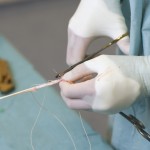

Subsequent instability and locking is common.
The anterior cruciate ligament (ACL) is the primary stabilising structure within the knee, limiting anterior translation of tibia on the femur as well as tibial internal rotation. Injuries are more common in high demand sports and usually follow non- contact trauma such as landing incorrectly from a jump, pivoting or decelerating suddenly, but can occur after direct contact or collision. Subsequent instability and locking is common and reconstructive surgery followed by lengthy rehabilitation is often required to stabilise the joint. Although there is general consensus that post-operative rehabilitation is essential, the components of programmes vary.
The aim of this review was to determine which rehabilitation components are supported by high quality systematic reviews to be included in a post-operative ACL reconstruction rehabilitation programme for a variety of outcomes including strength ROM (range of movement), pain, laxity, activity levels and return to sport (RTS)
Here’s what they did
Electronic databases were searched to April 2011 for systematic reviews published in English comparing any physiotherapy intervention from the day of isolated ACL reconstructive surgery with ‘standard treatment’.
Reviews were graded using criteria described by van Tulder et al (2003), where the level of evidence for each intervention outcome was dependent on the number and quality of RCTs for each intervention, e.g. Strong: consistent findings among multiple high quality RCTS, Moderate: consistent findings among multiple low quality RCTs and/or Clinical Control Trials (CCTs) and/or one high quality RCT.
The authors assessed risk of bias for each included review using the PRISMA checklist (LINK); the maximum score a review could achieve was 27.
Here’s what they found
Only five reviews were included assessing eight rehabilitation components. No evidence was found to strongly or moderately support a particular treatment. Many RCTs lacked detail on the use of different treatments at different time points, what the comparative ‘standard treatment’ was, or the amount of physiotherapy input. Conflicting evidence levels between reviews occurred because the primary outcomes of one were ‘function’ and ‘RTS’, which limited the number of studies included in that review (Trees et al. 2005). However they found
- Strong evidence of no added benefit of bracing (0-6 weeks) compared to standard treatment in the short term
- Moderate evidence of no added benefit of continuous passive motion to standard treatment for increasing range of movement
- Moderate evidence of equal effectiveness of closed versus open kinetic chain exercises on knee pain, laxity and function at 6-14 weeks
- Moderate evidence of equal effectiveness of home versus clinic based rehabilitation on knee laxity, ROM, strength and function at 6 – 12 months, and
- Limited evidence of no significant difference between accelerated (19 weeks) and non-accelerated (32 weeks) rehabilitation on function and knee laxity.
Four out of the five reviews scored 18 or less on the PRISMA quality checklist indicating a higher risk of bias. One review (Trees et al. 2005) scored 23 out of 27 [note that one of our Elves (Howe) was an author on this review].
The authors concluded
“The lack of clarity surrounding the amount of physiotherapy input with home based rehabilitation is important when considering the evidence that a home based exercise programme is equally effective as a clinic based programme”
The Musculoskeletal Elf’s view
 There still remains a question over what are the most effective components of ACL reconstruction rehabilitation programmes. However this review of systematic reviews identifies what components do not significantly improve outcomes and are therefore not recommended. More work has still to be done!
There still remains a question over what are the most effective components of ACL reconstruction rehabilitation programmes. However this review of systematic reviews identifies what components do not significantly improve outcomes and are therefore not recommended. More work has still to be done!
- Does this resonate with your experience of ACL rehabilitation?
- Are you surprised by the outcome of the review?
- Will it change your management of this condition?
Send us your views on this blog and become part of the Musculoskeletal Elf community.
Links
- Lobb R, Tumilty S, Claydon L S. 2012 A review of systematic reviews on anterior cruciate ligament reconstruction rehabilitation Physical Therapy in Sport, 13:4
- Moher D, Liberati A, Tetzlaff J, Altman DG, The PRISMA Group (2009) Preferred Reporting Items for Systematic Reviews and Meta-Analyses: The PRISMA Statement. PLoS Med 6(7): e1000097. doi:10.1371/journal.pmed.1000097
- Trees A H, Howe T E, Dixon J J, & White L C. 2005 ‘Exercise for treating isolated anterior cruciate ligament injuries in adults.’ Cochrane Database of Systematic Reviews1e41, CD005316
- van Tulder M, Furlan A, Bombardier C, & Bouter L. 2003 ‘Updated method guidelines for systematic reviews in the cochrane collaboration back review group.’ Spine, 28, 1290- 1299

I guess it’s like anything – some patients will fly through the rehab, others will need more supervision – either because they need their ‘hand held’ due to lack of confidence or because they are less familiar with specific targeted exercise (non athletic backround).
Of note one thing we have been discussing as pertinent to post-operative rehab is pre-operative planning. Addressing patients expectations of recovery and rehab is likely to have a significant effect on post-operative confidence, self management and overall recovery – something very hard to measure.
After rupturing my ACL, I was recommended a physio to aid the conditioning of the knee before I got back to anything strenuous. This has helped, but completely agree with Ciaran’s comment about expectations as so many of us rush the recovery which risks further injury. All about management and education.